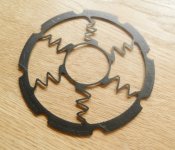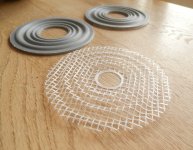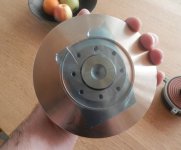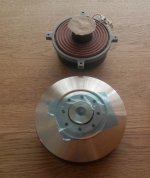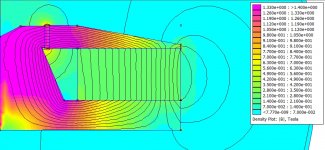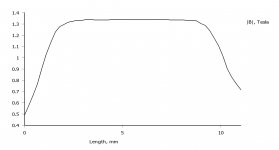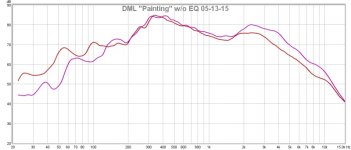I heard these awhile back at a demo in Las Vegas. They worked very well, I thought. I posted about them here or over on Audio Circle (I don't remember).Not many commercial products out there. Here are some of them:
Professional Distributed Mode Loudspeakers |
There must be some pro audio shows where you can see and hear them.
Very expensive and beautifully made. IIRC the panels are Kevlar honeycomb covered with a carbon fiber skin. Certainly DML done right, for sure.
I need to get back into playing with these. I would use rigid insulation panels in a somewhat triangular shape (fits the space) about 18x24x30 in. 45x60x75 cm more or less.
Any recommendations on which exciters?
I have been busy with other projects but meaning to get back here. I think I will 3d print my exciter spider and frame and adapt an old driver magnet and voice coil. Sort of copy one of those 4 legged "frog" like units I see in the PE catalog but with a big motor.
Just a little insperation for you, xrk971 😉 works wery well.
Thanks, Frank40 - I was thinking of something very similar. I was planning on using pentagonal symmetry to avoid usual transverse even order eigenmodes. One can make nice spiders with this method though - even dial in stiffness as needed.
Something like this?
That is very nice - but I like the multi hairpin turn springs better - your latest one is definitely acoustically transparent.
What material are you printing with? That doesn't look like PLA. Looks like nylon?
I have seen many who mount the exciter on the back of the membrane, but to me it would be logical to make the connection to the front as well. The reason is...... Most material will compress and expand when excited, especially foam, this will lead to loss of energy especially at high frequencies.
Also I have been thinking of combining DML and a “normal” speaker, to improve the high frequency. My thought is to use the wizzer from my full rang unit, as an exciter....With the compliance of the surrounding of wizzer I can control at what frequency the DML will take over. It's basic a speaker without a basket but mounted on the DML membrane.
I got the new magnets today... they are Hugh 😀, it will be one massive exciter. Here is some pic. And data.
Also I have been thinking of combining DML and a “normal” speaker, to improve the high frequency. My thought is to use the wizzer from my full rang unit, as an exciter....With the compliance of the surrounding of wizzer I can control at what frequency the DML will take over. It's basic a speaker without a basket but mounted on the DML membrane.
I got the new magnets today... they are Hugh 😀, it will be one massive exciter. Here is some pic. And data.
Attachments
It looks very impressive.
However, the bottleneck of HF is not at the driving force (strength of motor, suspension, etc.). DML works in a manner very different from ordinary speaker under high pressure.
Upper limit of frequency response is determined by the available density of waves on the panel. (When frequency goes higher and higher, there're more and more bumps and dips across the whole area.) So, the rigidity matters, the size of applying driving force matters.
And, don't be misled by the size of panel and its relation to the frequency response. A whole sheet of PS foam or foamcore board with the dimension of 180 x 90cm can play up to 20kHz. I believe other materials with proper characters can do that, too. And the radiation is very wide and effortless. You don't feel it forceful in near field, and it's attenuated very little when you step back (to the other end of the room). Overall, it's much much much better than any whizzer cone.
How big is your VC? From the pictures, I reckon it's 40mm perhaps? I don't have experience with such a big driver on DML. I've been using the cheap small one from PE with 25mm VC. With proper panel and mounting method, flat up to 20kHz is not a problem.
Big powerful driver is directly beneficial to the bass, though. LF needs large bumps and dips on the panel, which needs bigger driving force.
However, the bottleneck of HF is not at the driving force (strength of motor, suspension, etc.). DML works in a manner very different from ordinary speaker under high pressure.
Upper limit of frequency response is determined by the available density of waves on the panel. (When frequency goes higher and higher, there're more and more bumps and dips across the whole area.) So, the rigidity matters, the size of applying driving force matters.
And, don't be misled by the size of panel and its relation to the frequency response. A whole sheet of PS foam or foamcore board with the dimension of 180 x 90cm can play up to 20kHz. I believe other materials with proper characters can do that, too. And the radiation is very wide and effortless. You don't feel it forceful in near field, and it's attenuated very little when you step back (to the other end of the room). Overall, it's much much much better than any whizzer cone.
How big is your VC? From the pictures, I reckon it's 40mm perhaps? I don't have experience with such a big driver on DML. I've been using the cheap small one from PE with 25mm VC. With proper panel and mounting method, flat up to 20kHz is not a problem.
Big powerful driver is directly beneficial to the bass, though. LF needs large bumps and dips on the panel, which needs bigger driving force.

The view from the bed. Panels smaller, now hung on wall via single point attachment at top. Panels painted With spray and oil paint as a "painting" to match colors. I remain amazed how good a $25 pair of s##t car speakers, a panel, some wood, glue and sloppy paint job sounds [emoji12]
An actual test!
I know it is out of character for me to be serious, but I actually did some REW sweeps today and here is a plot. With a REW-generated EQ recommendation (I am using a DEQ2496 and just 4 PEQs) I am reasonably flat to 4K Hz and from there it drops about 12 dB/octave. As I said earlier, not bad for a large piece of foam insulation and a s##t car speaker bought at the local Appall-Mart 🙂
I'm not sure how REW accounts for this, but my EQ curve was with the "house curve" being the B&K suggested one (+3 at 20 Hz, down to -3 dB at 20 KHz.) but the highs go away rapidly even w/o EQ so is it really an issue 😕
I know it is out of character for me to be serious, but I actually did some REW sweeps today and here is a plot. With a REW-generated EQ recommendation (I am using a DEQ2496 and just 4 PEQs) I am reasonably flat to 4K Hz and from there it drops about 12 dB/octave. As I said earlier, not bad for a large piece of foam insulation and a s##t car speaker bought at the local Appall-Mart 🙂
I'm not sure how REW accounts for this, but my EQ curve was with the "house curve" being the B&K suggested one (+3 at 20 Hz, down to -3 dB at 20 KHz.) but the highs go away rapidly even w/o EQ so is it really an issue 😕
Attachments
Last edited:
Bien hecho Soldermizer los paneles y la obra artística, y que buen descanso despues del arduo trabajo. Quería preguntarle ¿Las voces suenan como dentro de una caja? Mis paneles siempre suenan como si la voz viniera de detrás del panel. Agradecería su amable respuesta.
Nice Soldermizer so you are an artist too !!! I always got the "Boxy" voices sound, like the singer voice came from behind, did you get rid this off your panels? Thanks
Nice Soldermizer so you are an artist too !!! I always got the "Boxy" voices sound, like the singer voice came from behind, did you get rid this off your panels? Thanks
Mexican. I have not noted any problem with voices, but mostly I am listening to instrumental electronic or jazz music. I am very pleased with the piano and sometimes other wood instrument like marimba.
Everything I've read about DML says you should not expect super imaging, but rather a laid back sound field although with surprises at Times.
Perhaps you are getting a boxy sound because you are using cardboard from a box for the paneling? [emoji41] [emoji41]
Xrk 971....I agree with your standard recommendation, but I have to wall mount them for them to be wall mounted speakers! Also, with EQ they actually have quite good bass.
Can't play 20 Hertz, of course but the panel does a shake your booty thing. [emoji276]
Everything I've read about DML says you should not expect super imaging, but rather a laid back sound field although with surprises at Times.
Perhaps you are getting a boxy sound because you are using cardboard from a box for the paneling? [emoji41] [emoji41]
Xrk 971....I agree with your standard recommendation, but I have to wall mount them for them to be wall mounted speakers! Also, with EQ they actually have quite good bass.
Can't play 20 Hertz, of course but the panel does a shake your booty thing. [emoji276]
Last edited:
Hanging some sound absorbing material on the rear side of the panels helps a lot in reducing early reflections and associated coloration.
I've used some 3M Thinsulate - puffy and batting like felt pad with good result. It's very light and soft and can be used in physical contact with the panel in quite large area without any problem. I guess it even provides extra damping by doing so.
I've used some 3M Thinsulate - puffy and batting like felt pad with good result. It's very light and soft and can be used in physical contact with the panel in quite large area without any problem. I guess it even provides extra damping by doing so.
Cool - nice to see more people playing around with the DML. Been playing around for a whle with it on "the other big thread" and have had fun along the way. Read earlier in the that some struggled with the bass. Hope you got it figured out (since that's the best part with the panels), but if not - make sure that you don't make it rigid at the wrong spot when you are leaning or holding it. The panel size is key as pointed out, but even if your panel is 6x 2ft, the spl drops fast below 200hz if edges are fixed at the wrong spots. Also make sure to not use panels that are too flexible such as too thin birch plywood or XPS. If you can easily flex it back and forth by hand or if it can't hold it's own weight unsupported, it may not be the best panel if you desire clean bass. I have had very good result with 1/4" birch ply that get you down to flat low 30hz (but at the expense at the HF that drops some around 10khz) - but you need some of the more powerful 40W Dayton exciters (or several of the smaller) to get the heavier panels sing. I know if goes against the theory with using heavier panels but I'm just following what my ears are telling me. When I tried using thinner birch boards, the bass collapses due to excessive vibration of the panels. Same thing happens when using too thin XPS. Thicker XPS are good too as many points out especially if "reskinned" as Sedge on the AC thread thought us.
For those
Looking fwd to learn more from the bright experimental people here!
For those
Looking fwd to learn more from the bright experimental people here!
- Home
- Loudspeakers
- Full Range
- A Study of DMLs as a Full Range Speaker


